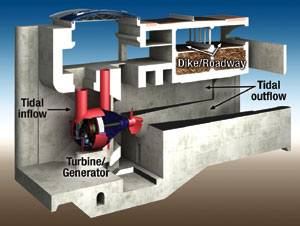 |
 |
| Rising Tide. Ten unidirectional bulb-type turbines will tap tidal inflow, which will purge South Koreas polluted Lake Shihwa when it ebbs into Inchon Bay. |
Equipment rated at 260 MW was recently ordered from Austria for the worlds largest tidal-energy powerplant, at Lake Shihwa, beside Inchon Bay in South Korea. The main contractor is now preparing to breach a long dike enclosing the coastal lake, south of Inchon, to build the powerhouse. As well as generating electricity, the plant will help flush the polluted lake, created in a failed attempt to store irrigation water.
Vienna-based VA Tech Hydro GmbH, will start delivering around $95 million-worth of equipment, including 10 bulb-type pipe turbines in the middle of next year, says Harald Schmid, who led the successful bid. The one-directional 7.5-meter-dia turbines will operate under a water head of around 8 m in a powerhouse built in the 12.7-kilometer-long embankment that has sealed the bay from the sea for over a decade.
Bidding in 2003, the Austrians competed with French and Chinese firms to supply a joint venture led by Daewoo Engineering & Construction Co. Ltd., Seoul. The Daewoo joint venture has a turnkey contract for the plant, said to be worth $250 million, with Korea Water Resources Corp., the state water authority. The plant is scheduled to start operating in the first half of 2009.
As well as toppling the current record holder, the 240-MW La Rance plant near St. Malô, France, the Korean project forms part of a plan to restore the marine environment and improve water quality. Lake Shihwa water has become so polluted by industrial discharges from the catchment that it is no good even for irrigation, according to Korea Ocean Research and Development Institute.
Letting up to 60 billion tons of seawater into the lake each year, the plant will help purge the effluent that caused the ambitious reclamation project to be abandoned in 2000. The dike, carrying a road, was completed in the mid-1990s to seal off mudflats and create a 40-sq-km freshwater lake. Other remedial measures in the governments $575-million lake management plan include wastewater treatment facilities.
The Lake Shihwa project puts South Korea ahead of China in tidal generation. Chinese officials from Liaoning province last year signed a memorandum of understanding with Tidal Electric Ltd., London, U.K., for a 300-MW facility. It is investigating engineering and economic aspects before environmental work, says company Chairman Peter Ullman. If built, the estimated $600-million project would be based on artificial tidal lagoons in shallow water outside the Yalu River (ENR 12/6/04 p. 15).
The South Korean project falls within the governments target of easing the countrys reliance on imported oil by boosting contributions of alternative energy sources to 5% in 2011, says Schmid. South Korea generated 329 million MWh in 2002 with hydro contributing 1.6% and other renewables generating under 1 million MWh, according to International Energy Agency data. Lake Shihwas tidal turbines will save nearly 900,000 barrels of oil a year, Schmid estimates.

Post a comment to this article
Report Abusive Comment